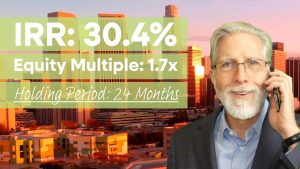Whether you’re underwriting a loan as a lender or negotiating loan terms as a borrower, loan-to-value (LTV) and debt-service coverage ratio (DSCR) should always be top of mind.
Objectives
- Understand the significant role of LTV and DSCR in loan underwriting.
- Learn how to calculate LTV and DSCR.
- Level up inquires and negotiations related to loan terms.
Listen to This Article
You’re speaking with a lender, inquiring about a loan for an investment property. All of a sudden, you’re told their requirements are a maximum loan-to-value ratio of 70% and a minimum debt-service coverage ratio of 1.25x. Okay, sure, but what does that mean? Let’s go through it.
Know the Lingo
First off, loan-to-value is typically shortened to LTV and debt-service coverage ratio is shortened to DSCR, or sometimes just DSC. Both LTV and DSCR are metrics used by lenders to gauge their exposure to risk when underwriting loans for investment properties. As a matter of fact, they’re the primary metrics used by lenders in most cases.
Loan-to-Value Ratio
Let’s start with LTV, which is generally more familiar to people because it’s also applicable to owner-occupied properties, such as your home. When some of you purchased the house where you currently live, you probably covered a portion of the purchase price with a down payment and financed the balance with a mortgage. To keep things simple, let’s assume the sale price was equivalent to market value. Take the amount of the loan and divide it by the value of the property. That’s the equation for LTV and the solution is expressed as a percentage.
Going back to our hypothetical conversation with that lender, you need a loan of $650,000 to acquire an investment property that you have under contract. The value of the property is $1,000,000. What’s the LTV? In this case, it would be 65%. The lender told you that maximum LTV is 70%. You only need 65%, so you’ve at least cleared that hurdle. From the lender’s perspective, the lower the LTV the better.
Debt-Service Coverage Ratio
Now, what about DSCR? It might seem a little more complicated, but we’ve got this. DSCR is basically an expression of how well the cash flow from an investment property covers the loan payments. It’s only applicable to investment properties because one of the necessary parts of the equation is net operating income, or NOI. If you’d like to take a deeper dive into NOI, see our video on that topic. For the time being, let’s keep it simple. NOI is rental income minus operating expenses.
Going back to our hypothetical transaction, let’s say annual rental income is $100,000, while operating expenses are $35,000 for the year. That means NOI is $65,000. The other number we’re going to need, in order to calculate DSCR, is the property’s annual debt service. That’s the total amount a borrower pays over the course of a year to service the loan. In other words, take the monthly loan payment and multiply it by 12. If the monthly payment is $4,250, the annual debt service is going to be $51,000.
Once you know both the NOI and the debt service, you’re ready to calculate the DSCR. Let’s continue with the examples from earlier in the video. NOI is $65,000 and debt service is $51,000. Dividing $65,000 by $51,000 results in a DSCR of 1.27. Depending on who you’re dealing with, the lender may sometimes affix an “x” to the end. In which case, it would be read as 1.27 times. The lender’s requirement in our hypothetical transaction was a minimum DSCR of 1.25x. You’ve exceeded that, which is a good thing. From the lender’s perspective, the higher the DSCR the better.
Remember the Lender's Perspective
So, to sum up, in order for a lender to consider your loan, at least as far as LTV and DSCR are concerned, the LTV for your deal will need to be less than the lender’s maximum LTV and the DSCR for your deal will need to be greater than the lender’s minimum DSCR.
There you have it. You can now calculate LTV and DSCR with the best of them. The next time you’re speaking with a lender, you’ll know exactly how to talk the talk.



















